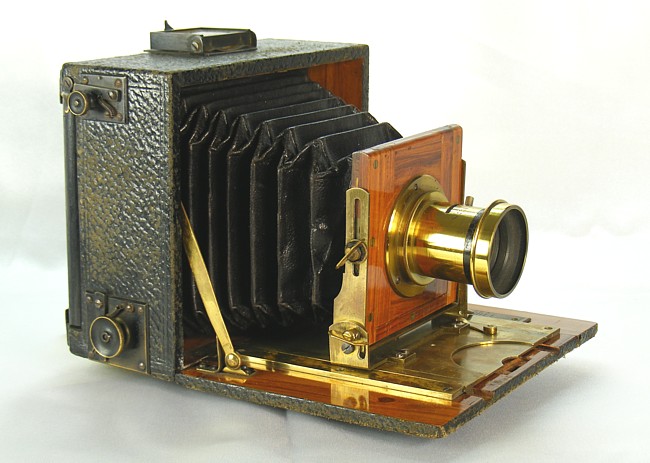Unknown Hand & Stand Camera
Manufacturer Unknown
| Name: | As yet to be identified |
| Type: | Hand & Stand camera |
| Manufacturer: | Unknown |
| Country of Origin: | TBC |
| Construction: | Unusual design leather covered wooden bodied hand & stand camera with brass fittings, barrel lens and a focal plane shutter. |
| Production Period: | Unknown |
| Plate / Film Size: | ¼ plate |
| Lens: | Unmarked f8 brass barrel lens; aperture set by lever that moves in slot |
| Shutter: | Focal plane shutter - means of operations not yet understood! |
| Movements: | Rising & cross front |
| Dimensions (w x h x l): | |
| Date of this Example: | c1900 |
| Serial Number: | None |
| Availability: |
|
| Inventory Number: | 134 |

Description
Unknown and unmarked ¼ plate camera, Lovely looking leather covered H & S style camera, with much brasswork in evidence. It has a focal plane shutter, though this is not working (and precise means of operation not understood anyway). There are absolutely no markings at all.
The seller thought the camera was English - I feel that it is more likely to be European, but cannot prove it. A possible clue is the fact that it has larger threaded tripod bushes, which suggests that it is unlikely to be British in origin.
The camera came with a single dark slide which is also made of brass.
The focal plane shutter cloth appears to be intact and will move slightly, but that is all (and brute force and ignorance will simply break it!).
The camera has a number of quite distinct features, which ought to make identification possible. When advertised originally, the seller described it as an English camera (it came from Canada), but I felt it was more likely to be European. This is about the only think I can confirm as it is equipped with the larger size tripod bush and is therefore unlikely to be British. I have always assumed that the camera is probably German. I'm guessing that it dates to about 1900.
There are no distinctive markings on the camera, lens or shutter mechanism that I have been able to find.
I had hoped that the pattern of the F-P shutter mechanism might help with identification, as there seem to have been a number of relatively standard designs that were adopted for cameras from companies such as Ernemann. However, I have as yet to find another camera with the same controls as this one. The F-P shutter appears to have settings for 1/20, 1/40, 1/60 and 1/80 marked on the "escapement" wheel that is just visible on the side of the body.
The camera would have been intended primarily for tripod use I would guess, given that there are fittings on the underside of the baseboard. One of the brass thumb screws is clearly intended to lock the double extension mechanism (the one in the slot), but the purpose of the other had defeated me initially.
However, there I was holding the camera rather clumsily to examine it more closely one day, and what happened next? Well, the inner track moved forward a nudge and I discovered the purpose of both adjusters underneath the camera. As suggested previously, the one set in the slot releases / locks the double extension but the other has now revealed itself to be the focusing adjustment (all seems very obvious now), acting on a toothed track built into lower of the two the inner brass plates on the baseboard. The lens standard can still be moved independently as it is attached to the top-most brass plate which can slide and has a locking lever of its own adjacent to the lens standard, presumably to allow for 'fine-focus'.
The camera has a rising and cross-front, with distinctive fittings. In fact the whole structure of the overlapping thin brass plates on the baseboard is unusual.
The tapered bellows are a deep maroon colour, with 45 degree corners.
Notes
Speculation on the WoodAndBrass group on yahoo has proposed that the camera is perhaps more likely to be French rather than German. The aperture markings, set by a radial lever, are one hint - the scale is marked f8 through to f64, with interim markings at f11, 16, 22, 32 & 44. One of the respondents on WoodAndBrass noted firstly that this is a "regular" f-stop scale and not Stolze, U.S, AN or something like that. Second, many of the German makers who used "regular" f-stops would have marked the stops 8, 11, 16, 23, 32, 45, 64. So 22 and 44 are less likely on German lenses than 23 and 45 - or 22 and 45.
A search in Thomas International does not allow any further identification, but there are some vague similarities in style to key French makers such as the Takyra by Krauss. More investigation required!
If you are able to share any further information about this camera, please contact me.
![[ ]](../../images/unchecked.png)
![[x]](../../images/checked.png)